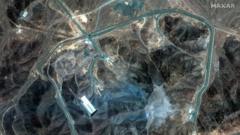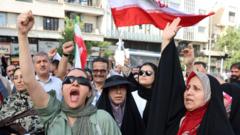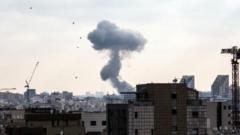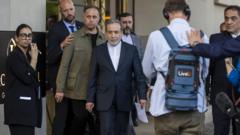In a bold military operation dubbed "Operation Midnight Hammer," the United States struck three key nuclear facilities in Iran, marking a severe uptick in hostilities. President Donald Trump affirmed the success of the bombing, claiming that significant damages were caused to the sites, namely Fordo, Natanz, and Isfahan. The operation involved a massive deployment of military assets, including B-2 stealth bombers and Tomahawk missiles. While the Iranian government has labeled the assault as a violation of international law, it asserts that its nuclear capabilities remain intact. With retaliation imminent, the geopolitical landscape continues to shift.
US Launches Major Airstrikes on Iranian Nuclear Facilities

US Launches Major Airstrikes on Iranian Nuclear Facilities
The Pentagon confirms extensive bombings on Iran's major nuclear sites amid escalating tensions.
The details of the attack reveal a well-coordinated effort between the US and Israel, with claims of extensive bomb damage being confirmed by military officials. The Pentagon stated that all three targeted sites suffered serious destruction, yet Iranian officials quickly countered these assertions, claiming the facilities were not seriously impacted as key materials were evacuated prior to the strike.
The operations utilized 125 military aircraft and high-precision munitions, including GBU-57 Massive Ordnance Penetrators, designed to penetrate hardened targets like the Fordo site, which lies deep beneath the surface, posing unique targeting challenges. Following the airstrikes, satellite reports indicated signs of destruction, with fresh craters marking the impact zones, although some analysts suggested the targets may have been prepared for potential strikes.
In retaliation, Iran launched missiles at Israeli cities, signalling a potential escalation into wider conflict. Iranian leadership has expressed strong intentions to respond to this attack, while President Trump warned that future military actions would be even more severe unless Iran engages diplomatically.
Domestic and global reactions to the airstrikes vary, with some factions in the US Congress voicing concerns over the legality and rationale for the attack. Meanwhile, allies in Europe and the Middle East are urging restraint from all parties to avoid further destabilization of the region. The ongoing conflict underscores the deepening rift between Iran and Israel, with strategic ramifications that could extend beyond the immediate violence.
As tensions mount, the world watches closely, contemplating the implications of this conflict not just for the US and Iran, but for global security dynamics as a whole.
The operations utilized 125 military aircraft and high-precision munitions, including GBU-57 Massive Ordnance Penetrators, designed to penetrate hardened targets like the Fordo site, which lies deep beneath the surface, posing unique targeting challenges. Following the airstrikes, satellite reports indicated signs of destruction, with fresh craters marking the impact zones, although some analysts suggested the targets may have been prepared for potential strikes.
In retaliation, Iran launched missiles at Israeli cities, signalling a potential escalation into wider conflict. Iranian leadership has expressed strong intentions to respond to this attack, while President Trump warned that future military actions would be even more severe unless Iran engages diplomatically.
Domestic and global reactions to the airstrikes vary, with some factions in the US Congress voicing concerns over the legality and rationale for the attack. Meanwhile, allies in Europe and the Middle East are urging restraint from all parties to avoid further destabilization of the region. The ongoing conflict underscores the deepening rift between Iran and Israel, with strategic ramifications that could extend beyond the immediate violence.
As tensions mount, the world watches closely, contemplating the implications of this conflict not just for the US and Iran, but for global security dynamics as a whole.























